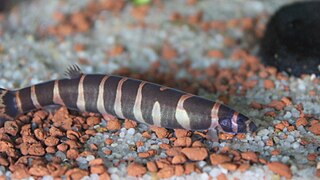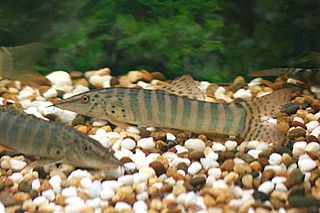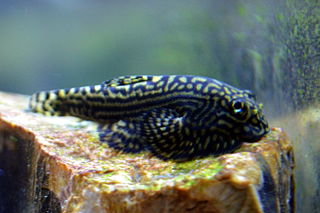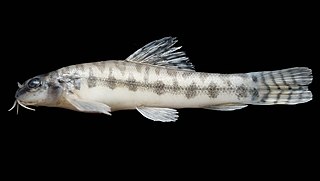
Cobitidae, also known as the true loaches, is a family of Old World freshwater fish. They occur throughout Eurasia and in Morocco, and inhabit riverine ecosystems. Today, most "loaches" are placed in other families. The family includes about 260 described species. New species are being described regularly.

Balitoridae, the hillstream loaches or river loaches, is a family, of small fish from South, Southeast and East Asia. The family includes about 202 species. They are sometimes sold as "lizardfish" or "flossensaugers". Many of the species are popular for aquaria, species in the genus Sewellia are most commonly sold in the aquaria trade. They have a number of similarities with the Cobitidae, their sibling family of "loaches", such as multiple barbels around the mouth. They should not be confused with the loricariids, which look similar but are a family of catfish.

Pangio is a genus of small Asian freshwater fish in the true loach family Cobitidae. In earlier taxonomic schemes it was known as Acanthophthalmus. The "kuhli loach" is well-known in the aquarium trade and commonly identified as P. kuhlii, but most individuals actually appear to be P. semicincta.

Misgurnus is a genus of true loaches found in Europe and Asia. The origin of the name Misgurnus comes from the Greek word miseo and the Turkish gür (loud), a name given to them due to their habit of becoming very active during barometric pressure changes that occur during thunderstorms. The common names, weather loach or weatherfish, also derive from this behavior. Some species of misgurnus are eaten, mostly in Asia, and are also sold as pets in the aquarium trade. Their average size can range from 6 to over 12 inches.
Acanthocobitis is a genus of freshwater ray-finned fish of the stone loach family, Nemacheilidae. Recent work has suggested that the genus be split into two with the former subgenus Paracanthocobitis being raised to a full species, leaving just the type species, Acanthocobitis pavonacea, in the current genus.

Lepidocephalichthys is a genus of ray-finned fish in the family Cobitidae.

Nemacheilus is a genus of stone loaches native to Asia.

The golden loaches (Sabanejewia) are a genus of ray-finned fish in the family Cobitidae.

Botiidae, the pointface loaches, is a family of cypriniform ray-finned fishes from South, Southeast, and East Asia. Until recently they were placed in the true loach family Cobitidae, until Maurice Kottelat revised the loaches and re-elevated this taxon to family rank in 2012. The family includes about 56 species.

Acantopsis dialuzona is a loach native to the swift, clear streams and rivers of mainland and archipelagic Southeast Asia, Indonesia, Peninsular Malaysia, Thailand, but Southeast Asia outside its range, including as Acantopsis. A. choirorhynchos because of the lack of taxonomic resolution in Acantopsis. It can also be found in flooded fields.

Loaches are ray-finned fish of the suborder Cobitoidei. They are freshwater, benthic (bottom-dwelling) fish found in rivers and creeks throughout Eurasia and northern Africa. Loaches are among the most diverse groups of fish; the 1249 known species of Cobitoidei comprise about 107 genera divided among 9 families.
Iskandaria is a genus of freshwater ray-finned fishes beloning to the family Nemacheilidae, the stone loaches. The two species in this genus are found in northern Central Asia.

Sewellia is a genus of fish in the family Gastromyzontidae. They are commonly called hillstream loaches and are found in Laos and Vietnam. According to Roberts (1998) a possible defining characteristic of the genus Sewellia is their posterior pelvic valve is highly complex and different from other rheophilic loaches, their posterior pelvic valve involves the overlapping of the second to last ventrally exposed rays. Adapted to high velocity streams, Sewellia have depressed body shapes that are laterally expanded, thus increasing their hydrodynamical properties and allowing them to better stay attached to rocks in swift current. Sewellia also have paired fins with a single simple ray and numerous branched rays allowing them to grip rocks in swift current.
Acanthopsoides is a genus of freshwater ray-finned-fishes belonging to the family Cobitidae, the true or spined loaches. These small fishes are found in Asia.
Bibarba is a genus of loach that is found in the Chengjiang River and Hongshuihe River in China.

Serpenticobitis, popularly known as serpent loaches, is a small genus of loaches found in the Mekong River Basin in Southeast Asia. It is the only genus in the family Serpenticobitidae.

Balitoropsis also known as the lizard loaches is a genus of freshwater ray-finned fishes belonging to the family Balitoridae, the loaches in this family are commonly known as hillstream loaches although this name also refers to the loaches in the family Gastromyzontidae. These loaches are found in mainland Southeast Asia, Sumatra and Borneo.

Homalopteroides is a genus of freshwater ray-finned fishes belonging to the family Balitoridae, the loaches in this family are commonly known as hillstream loaches although this name also refers to the loaches in the family Gastromyzontidae. These loaches are found in Southeast Asia.

Paracanthocobitis is a genus of freshwater ray-finned fishes belonging to the family Nemacheilidae, the stone loaches. This genus is known from the Indus basin in Pakistan to the Mekong basin of Cambodia and Laos The type species is Paracanthocobitis zonalternans. Some authorities treat this as a subgenus of Acanthocobitis
Petruichthys salmonides is a little known species of freshwater ray-finned fish belonging to the family Nemacheilidae, the stone loaches. It is known only from the holotype which was collected at "Mongpan" in southern Yunnan and described by B. L. Chaudhuri. It has been considered to be a synonym of Yunnanilus pleurotaenia but Yunnanilus fishes have restricted distributions that are disjunct from the given type locality of this species and Chaudhuri's original description does not match any Yunnanilus species. This species has been regarded as a species inquirenda but Eschmeyer's Catalog of Fishes treats it as a valid recognised species within Petruichthys.















